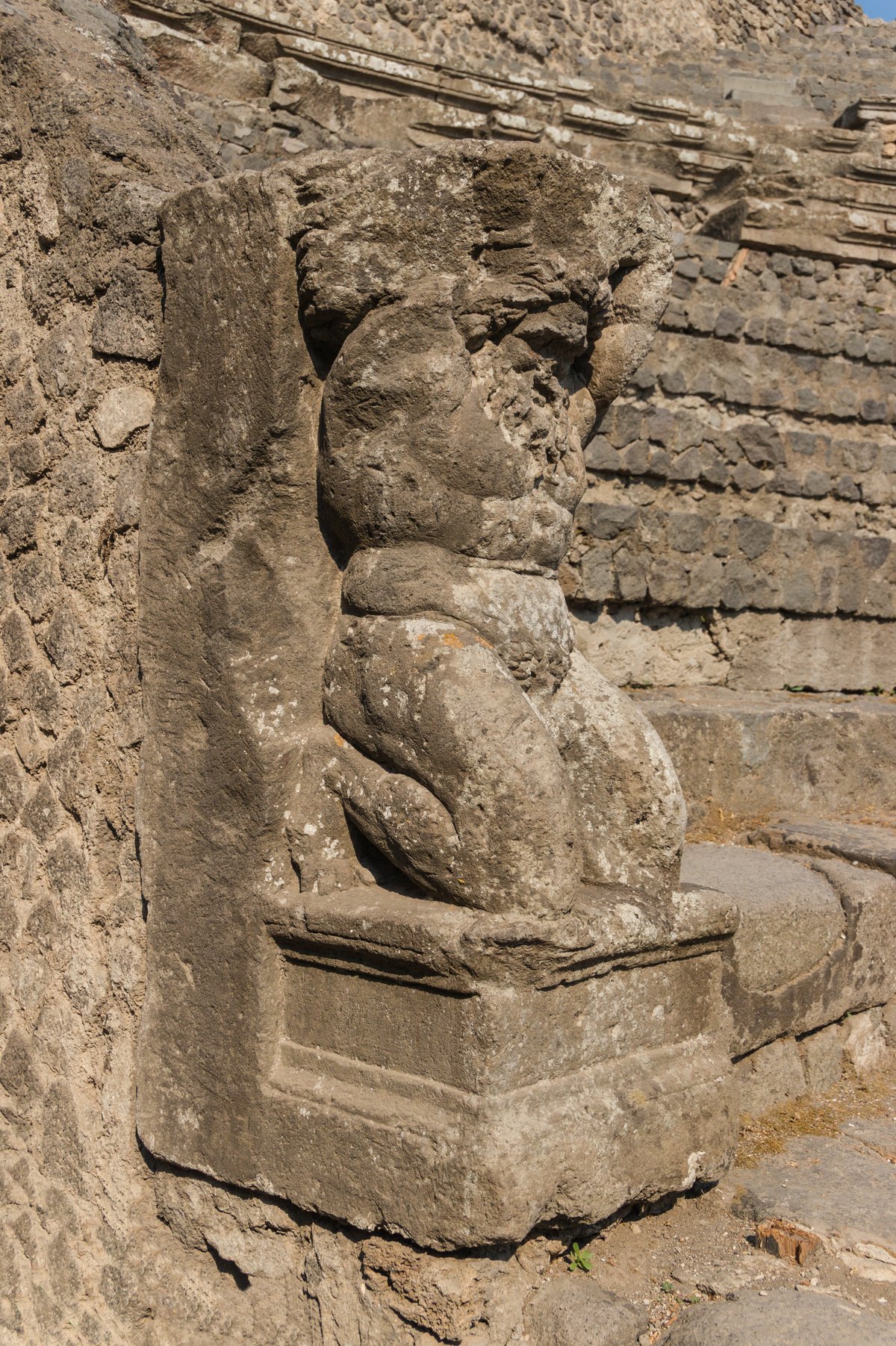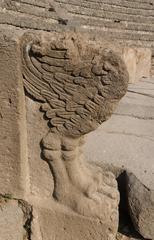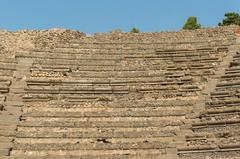
Little Theatre of Pompeii: Visiting Hours, Tickets, and Historical Significance Guide
Date: 15/06/2025
Introduction: A Gateway to Pompeii’s Cultural Heritage
Nestled in the heart of the ancient city, the Little Theatre of Pompeii—also referred to as the Odeon or Teatro Piccolo—offers visitors an extraordinary opportunity to experience the sophistication of Roman civic and artistic life. Built between 80 and 75 BCE during Pompeii’s transition into a Roman colony, this theatre stands as one of the city’s most evocative and best-preserved monuments. Distinguished from the neighboring larger theatres by its covered roof and more intimate scale, the Odeon was a venue dedicated primarily to music, poetry, and oratory. Its thoughtful architecture, refined acoustics, and enduring marble details reflect both Roman ingenuity and the city’s vibrant social stratification. Today, the Odeon remains a testament to Pompeii’s cultural richness and is a must-see for travelers eager to delve into the city’s storied past.
For up-to-date information on visiting hours, ticketing, accessibility, and guided tours, consult the official Pompeii Archaeological Park website and the Audiala app for immersive audio guides and maps (Pompeii Archaeological Park, Ancient Theatre Archive, Savoring Italy).
Contents
- Introduction
- Historical Background and Architecture
- Cultural and Social Importance
- Visitor Information: Hours, Tickets, and Accessibility
- How to Reach the Little Theatre
- Nearby Attractions and Photographic Highlights
- Special Events and Cultural Programs
- Guided Tours and Digital Resources
- Practical Tips for Visitors
- Family-Friendly Advice
- Frequently Asked Questions (FAQ)
- Conclusion and Next Steps
- Sources
Historical Background and Architectural Highlights
The Little Theatre of Pompeii was commissioned by the duumviri Marcus Porcius and Quintus Valgus. Built adjacent to the larger open-air theatre, the Odeon forms part of Pompeii’s dynamic southwest theatre district. The structure blends Greek design elements—such as the deeply embanked cavea (seating area)—with Roman construction techniques using volcanic tuff, Sarno limestone, and opus caementicium (Roman concrete).
Capacity ranged from 1,000 to 1,500 spectators, with seating meticulously divided to reflect social hierarchies; the lower rows were reserved for Pompeii’s elites and priests, while the general populace occupied the upper tiers. The now-lost wooden roof enhanced the venue’s acoustics and protected audiences from the elements, making the Odeon ideal for refined performances and civic gatherings. The marble-inlaid orchestra floor and decorative remains are highlights for today’s visitors.
Cultural and Social Importance
Central Role in Pompeian Society:
The Odeon was the epicenter for musical contests, poetry recitals, public speeches, and occasional civic meetings. Unlike the larger Teatro Grande, which hosted dramatic plays for thousands, the Odeon fostered a more exclusive environment tailored to the city’s upper class (Ancient Theatre Archive).
Social Stratification:
Seating arrangements underscored the rigid social hierarchy of Pompeii, with the best seats reserved for magistrates and prominent families. Graffiti and inscriptions attest to the lively social interactions and networking that occurred here (Planet Pompeii).
Artistic and Political Life:
The Odeon’s exclusive programming promoted rhetorical skill, music, and literary culture. Occasionally, political assemblies and important civic announcements also took place within its walls (Italy Sights).
Modern Relevance:
The Odeon’s preservation allows for occasional modern performances, offering contemporary audiences the chance to experience its famed acoustics and atmosphere (Savoring Italy).
Visitor Information: Hours, Tickets, and Accessibility
Visiting Hours
- April to October: 9:00 AM – 7:00 PM (last entry at 6:00 PM)
- November to March: 9:00 AM – 5:00 PM (last entry at 4:00 PM)
- Closed: December 25, January 1, and May 1
Always confirm hours and any special closures or events on the official Pompeii Archaeological Park website.
Tickets
- General Admission: €16–€18 for adults (booking fee may apply)
- Reductions: Lower rates for EU citizens aged 18–25; free entry for children under 18
- Purchase: Book online via official ticket portal or authorized resellers to avoid queues and secure preferred entry times
Accessibility
- Mobility: Lower seating accessible via ramps; upper tiers require stairs. Ancient paving stones can be uneven—sturdy footwear is essential.
- Assistance: Consult the official accessibility map and inquire about accessible tours if needed.
How to Reach the Little Theatre
Located in Region VIII of the archaeological park, the Little Theatre is adjacent to the Teatro Grande and near the Triangular Forum. The main visitor entrances—Porta Marina and Piazza Anfiteatro—provide straightforward access, with clear signage and maps available onsite (Stories by Soumya). The site is within walking distance from the Pompeii Scavi - Villa dei Misteri train station.
Nearby Attractions and Photographic Highlights
- Teatro Grande: The adjacent large theatre offers a striking contrast in scale.
- Triangular Forum: An ancient civic and religious hub nearby.
- House of the Faun & House of the Vettii: Elite residences showcasing opulent Roman domestic life.
- Gladiator Barracks and Quadriporticus: Explore Pompeii’s entertainment and training quarters.
- Photographic Spots: The Odeon’s orchestra floor with marble inlays and fragments of wall painting are particularly striking in morning light (Greta’s Travels).
Special Events and Cultural Programs
During summer, the Little Theatre hosts performances as part of the Pompeii Theatrum Mundi festival. These events require separate ticketing and advance bookings due to limited seating (Ancient Theatre Archive). Check the official events calendar for current offerings.
Guided Tours, Audio Guides, and Digital Resources
- Guided Tours: Available in multiple languages, often led by archaeologists or expert guides (Savoring Italy).
- Audio Guides: Rent at entrances or use the Audiala app for self-paced exploration.
- Digital Maps & Virtual Tours: Accessible on the official Pompeii website.
Practical Tips for Visitors
- Best Times: Early morning or late afternoon for cooler temperatures and fewer crowds. Weekdays and shoulder seasons (May, October) are optimal (Nomadic Matt).
- What to Bring: Comfortable shoes, sun protection, and water.
- Facilities: Restrooms and water fountains are located nearby.
- Photography: Non-flash photos are permitted for personal use; tripods/professional gear require permission.
Family-Friendly Advice
The evocative setting of the Odeon can inspire children’s imaginations. Family workshops and the new Pompeii Children’s Museum (opening 2025) further enhance the educational experience (Finestre sull’Arte).
Frequently Asked Questions (FAQ)
Q: Do I need a separate ticket for the Odeon?
A: No, entry is included with the general Pompeii archaeological site ticket.
Q: What are the Little Theatre’s visiting hours?
A: Generally, 9:00 AM – 7:00 PM (April–October), 9:00 AM – 5:00 PM (November–March); last entry one hour before closing.
Q: Is the Odeon accessible for visitors with mobility challenges?
A: The lower seating is accessible by ramps, but upper tiers require stairs. Use the official accessibility map for planning.
Q: Are guided tours available?
A: Yes, many tours include the Little Theatre, and audio guides are widely available.
Q: Can I take photos inside the Little Theatre?
A: Yes, non-flash photography is permitted for personal use.
Conclusion and Next Steps
The Little Theatre of Pompeii is a window into the artistic, social, and architectural achievement of ancient Roman society. By planning ahead—consulting official resources, booking tickets online, and considering guided or audio tours—you can make the most of your visit. Engage with the site respectfully to help preserve its legacy for generations to come.
For further updates, ticket bookings, and digital resources:
Sources
- Pompeii Archaeological Park
- Ancient Theatre Archive
- Savoring Italy
- Stories by Soumya
- Planet Pompeii
- Italy Sights
- Nomadic Matt
- Greta’s Travels
- Finestre sull’Arte
- Walks of Italy
- BeeLoved City
- A Ticket to Take Off



































































